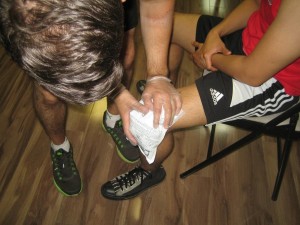The meniscus is a portion of cartilage that cushions the thighbone and the shinbone. In each knee joint, there are two menisci. A meniscus tear can occur during activities that put pressure on the knee joint as well as movements that rotate it.
The available treatment options include home remedies as well as outpatient surgery. This depends on the severity of the injury. Injuries can be prevented by performing exercises that strengthen the leg muscles and using appropriate methods during contact sports and activities.

Causes of meniscus tear
The meniscus can be torn during activities that involve direct pressure or contact from a forced rotation or twist. An abrupt turn or pivot, heavy lifting and deep squatting can result to injury. Sports such as basketball, football, tennis and soccer will put an individual at threat for meniscus tears.
The meniscus tends to weaken as one ages and the tears are more common in individuals. Stepping or squatting can cause injury if the meniscus is weak. Individuals who have osteoarthritis are at higher risk for injuring the knee or tearing the meniscus.
Symptoms of a meniscus tear
Once a meniscus tear occurs, you might hear a popping sound surrounding the knee joint. The individual will experience:
- Pain once the affected area is moved or touched
- Inflammation
- Trouble ambulating the knee or incapacity to move it in complete range of motion
- Sensation of the knee locking
- Sensation that the knee is unable to provide support
In some cases, there is a popping sensation that usually indicates that a piece of cartilage is loose and blocking the knee joint.
It is important to consult a doctor if any of these symptoms are experienced and if they last for more than a few days or occur right after the knee has been injured. In case the knee locks and the individual could not bend it after straightening it, it is best to consult a doctor right away.
How a meniscus tear is diagnosed
After discussing the symptoms, the doctor will examine the knees and test the range of motion. The area where the meniscus is located will be closely examined. A McMurry test will be performed to determine if a meniscal tear is present. The test involves bending the knee, straightening it and rotating it. If a slight pop is heard during the test, it indicates that there is a meniscal tear.
Imaging tests are also performed to confirm a meniscal tear. It includes a knee X-ray, magnetic resonance imaging and an ultrasound.
In case the doctor could not determine the cause of the knee pain, arthroscopy might be recommended.
[youtube url=”http://www.youtube.com/watch?v=iIWJJUcuMfM”]How to treat a meniscus tear
Primarily, a knee injury should be treated with first aid measures at home including the RICE method.
- Rest the affected knee. Crutches can be used to avoid weight on the joint and avoid activities that will worsen the pain.
- Ice the affected knee every 3-4 hours for 30 minutes
- Compress or cover the knee using an elastic bandage to minimize inflammation
- Elevate the knee to minimize swelling
Medications for pain relief and non-steroidal anti-inflammatory drugs can be given. Your doctor might recommend physical therapy to strengthen the muscles bordering the knee.